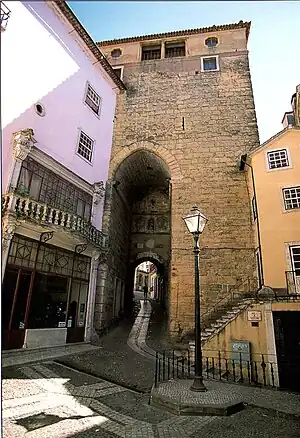| Siege of Coimbra (1117) | |||||||
|---|---|---|---|---|---|---|---|
| Part of Reconquista | |||||||
 Medieval gateway in Coimbra. | |||||||
| |||||||
| Belligerents | |||||||
|
|
| ||||||
| Commanders and leaders | |||||||
|
| ||||||
| Strength | |||||||
| Unknown | Unknown | ||||||
| Casualties and losses | |||||||
| Unknown | Thousands dead | ||||||
The siege of Coimbra of 1117 was a military engagement between the forces of the Almoravid dynasty and those of the County of Portugal in the city of Coimbra. In 1117, the Almoravids launched a campaign into the County of Portugal to attack the city of Coimbra and withdrew after failing to capture it.
Background
In 1111, the Almoravids attacked Portugal, captured Santarém and raided as far as Coimbra.[4] A Moorish attack on Coimbra had been anticipated before the death of Count Henry, but it did not take place until 1116. In this year, the Almoravid forces led by Abdul-Malik seized two fortresses that protected the city, Miranda de Beira and Santa Eulalia. They put the garrison of the first to the sword and enslaved the second, including its governor, Diogo. The defenders of Soure thinking resistance was useless, left their base and took shelter in Coimbra. This attack effectively destroyed the outer defenses of Coimbra.[5]
In 1117, the Almoravids, led by Ali ibn Yusuf landed at Montemor-o-Velho and Portuguese lands again.[6] He brought African forces reinforced by Andalusians, as many as the "grains of the sand of the sea," according to one chronicle.[7]
Siege
The Almoravids attacked the outskirts, killing and enslaving. The Portuguese weren't able to push back the Almoravids, and many retreated within the castle, including countess Theresa. The city was surrounded for 20 days and the suburbs sacked.[8] The Almoravids subjected Coimbra to daily assaults, however they were ultimately unable to take it and the walled city remained undamaged.[9][10][11][12]
Ali then withdrew from the city to Seville. Keeping Coimbra would have proven hard for the Almoravids to defend in a hostile land.[13][14][15][16]
The siege of Coimbra marked the height of Almoravid power in Iberia.[17] After the successful defense of Coimbra, Countess Theresa started addressing herself as queen.[18]
See also
Bibliography
- Muhammad Abdullah Enan, The State of Islam in Andalusia, Vol. III: The Era of Almoravids and Almohads, Part 1, p. 81
- H. V. Livermore, A history of Portugal, p. 55-6
- Hugh Kennedy, Muslim Spain and Portugal, A Political History of Al-Andalus.
- Bernard F. Reilly, The Contest of Christian and Muslim Spain 1031 - 1157.
- Freddy Silva: First Templar Nation Simon and Schuster, 2017.
- Jorge de Alarcão: Coimbra: A Montagem do Cenário Urbano, Imprensa da Universidade de Coimbra / Coimbra University Press, Jan 1, 2008, pp. 204–205.
- João Diogo Rodrigues de Carvalho: Santarém e a Reconquista: a Tomada da Cidade, 2022, Universidade de Lisboa, p. 34.
- Brian A. Catlos, Muslims of Medieval Latin Christendom, C. 1050-1614.
References
- ↑ Reilly, 1996, p. 143
- ↑ Freddy Silva: First Templar Nation Simon and Schuster, 2017.
- ↑ Martim Velho: O Ataque a Miranda, Santa Eulália e Soure em 1116, p. 173.
- ↑ Muhammad Abdullah Enan, p. 70
- ↑ H. V. Livermore, p. 55
- ↑ João Diogo Rodrigues de Carvalho, p. 143
- ↑ H. V. Livermore, p. 55
- ↑ H. V. Livermore: A History of Portugal, Cambridge University Press, 1947, p. 56.
- ↑ "The king of the Saracens, Ali ibn Iusuf, coming from the other side of the sea with a numerous army, encircled Coimbra, having been joined by all of his forces on this side of the sea, the number of his soldiers being as great as the sand of the sea and only God knowns it. Efectively he sieged Coimbra and for twenty days he daily attacked it harshly with all his army but, by will of God, couldn't do harm to it and the city remained unharmed as did its inhabitants". A CRÓNICA DOS GODOS" in O Portal da História at arqnet.pt
- ↑ Bernard F. Reilly, p. 143
- ↑ Jorge de Alarcão:pp. 204-205.
- ↑ João Diogo Rodrigues de Carvalho, p. 143
- ↑ Muhammad Abdullah Enan, p. 81
- ↑ H. V. Livermore, p. 56
- ↑ Hugh Kennedy
- ↑ Brian A. Catlos, p. 28
- ↑ Bernard F. Reilly, p. 143
- ↑ Freddy Silva